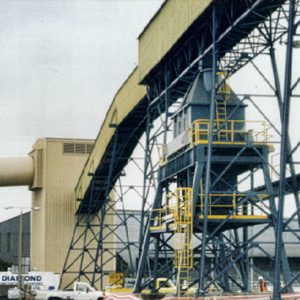Modern Industrial Coatings Provide the Ultimate in Surface Protection

Todays industrial protective coatings are much more effective!
Industrial equipment, machinery, and structures are exposed to many harsh environmental and physically abrasive and damaging conditions during their everyday usage and entire lifespan.
Chemicals, extreme temperatures, and weather are just some of the conditions that can potentially corrode, damage, or degrade metallic and non-metallic materials. Industrial coatings applied to exposed surfaces are an economical protection method to reduce repair and replacement costs and to extend the durability and useable life of the devices and structures.
Iron oxide, more commonly known as rust, is one of the most aggressive “diseases” that can attack metallic surfaces.
Steel, which is an iron-based compound metal, is particularly susceptible to the often terminal condition.
However, chemistry and technology advancements have resulted in the development of many types of protective industrial paints and formulations that can help to reduce the risk of rust and other material degrading forces.
Todays industrial protective coatings are much more effective!
Protective industrial paint systems are manufactured for many environmentally and physically challenging conditions, which include, but are not limited to the following types of formulations:
• Abrasion and scratch resistant
• Anti-microbial
• Chemical resistant, various chemical classes
• Cold-resistant
• Color fade resistant
• Electromagnetic interference (EMI) and radio frequency interference (RFI)
• Enamels
• Epoxies
• Graffiti-resistant
• Heat-resistant
• Low-friction
• Lubricants
• Mold and mildew resistant
• Non-stick
• Oil-resistant
• Powder coatings (various protective uses)
• Rust-inhibiting
• Slip-reduction/textured paints
• Stain-resistant
• Surface primers
• Water-resistant/waterproof
Each of these protective coatings is formulated for endurance and protection of your valuable equipment issues, machinery, and structures.
Equipment, machinery, and structural protection or restoration is insurance for you and your client.
When all the devices are functioning properly, the business is in operation and workers are employed.
Corroded or degraded devices can be faulty or hazardous to operate, which can result in worker or public health and safety issues.
Faulty devices or safety hazards can also result in litigation for you or your client.
Industrial paints on publically accessible or visible functional and utilitarian structures such as bridges, provides visual appeal.
Structure protection also saves the taxpayers money on repair, replacement, and restoration costs of corroded or degraded devices.
Before an industrial paint system is applied, the surfaces must be completely clean and free of any impurities or residues.
All grease, oil, old paint, rust, and other coatings must be removed to expose the bare surface of the material undergoing restoration and protective treatments.
Sandblasting is one of most common industrial methods for preparing large-scale damaged surfaces prior to restoration and application of protective paint.
Restoration of contaminated, corroded, deteriorated, greasy, or soiled equipment, machinery, or structures can be only be successfully performed and completed if the surfaces are properly prepared.
The application of a primer and industrial protective coating is an easy and relatively inexpensive process to protect equipment, machinery, and structures from harsh environmental conditions, physical wear, and weathering.
It is much more economical to restore and protect your valuable investments, rather than incurring repair and replacement costs and employee and project downtime.
The right choice of industrial paint systems and coatings can also add visual appeal to your devices for a clean and professional look.
References
“Abrasive blasting”
http://en.wikipedia.org/wiki/Abrasive_blasting
Accessed 24 OCT 2011
“Abrasive Blasting and Applications of Protective Coatings”. Diamond PCS.
http://diamondpcs.com.au/pop_abrasiveblast.html
Accessed 17 OCT 2011
“Abrasive Blasting”. Centers for Disease Control and Prevention.
http://www.cdc.gov/niosh/topics/blasting/
Accessed 17 OCT 2011
“Abrasive Blasting Operations. Engineering Control and Work Practice Method”. Enviro-Management & Research Inc., Washington, D.C. Final Report. U.S. Dept of Health Education, and Welfare. March 1976.
http://www.cdc.gov/niosh/docs/76-179/pdfs/76-179.pdf
Accessed 17 OCT 2011
Coatings Advisor
http://www.coatingsadvisor.com/
http://www.coatingsadvisor.com/listings89.html
Accessed 22 OCT 2011
General Services Brochure. The Society for Protective Paints
http://www.sspc.org/media/documents/general_services_brochure.pdf
Accessed 18 OCT 2011
“Industrial Abrasives”. Abrasive Technology. http://www.abrasive-blasting.net/
Accessed 17 OCT 2011
“Industrial Coating”
http://en.wikipedia.org/wiki/Protective_coatings
Accessed 20 OCT 2011
Industrial Coating Information
Accessed 20 OCT 2011
Industrial Coating World
http://industrialcoatingsworld.com/
Accessed 30 OCT 2011
Metal Coatings Corp.
Accessed 20 OCT 2011
The Ingredients of Paint and Their Impacts on Paint http://www.industrialpaintquality.com/pdfs/ingredientsofpaint.pdfProperties
Accessed 26 OCT 2011
The Society for Protective Coatings
Accessed 18 OCT 2011
Tnemec Company
http://www.tnemec.com/product/
Accessed 26 2011
